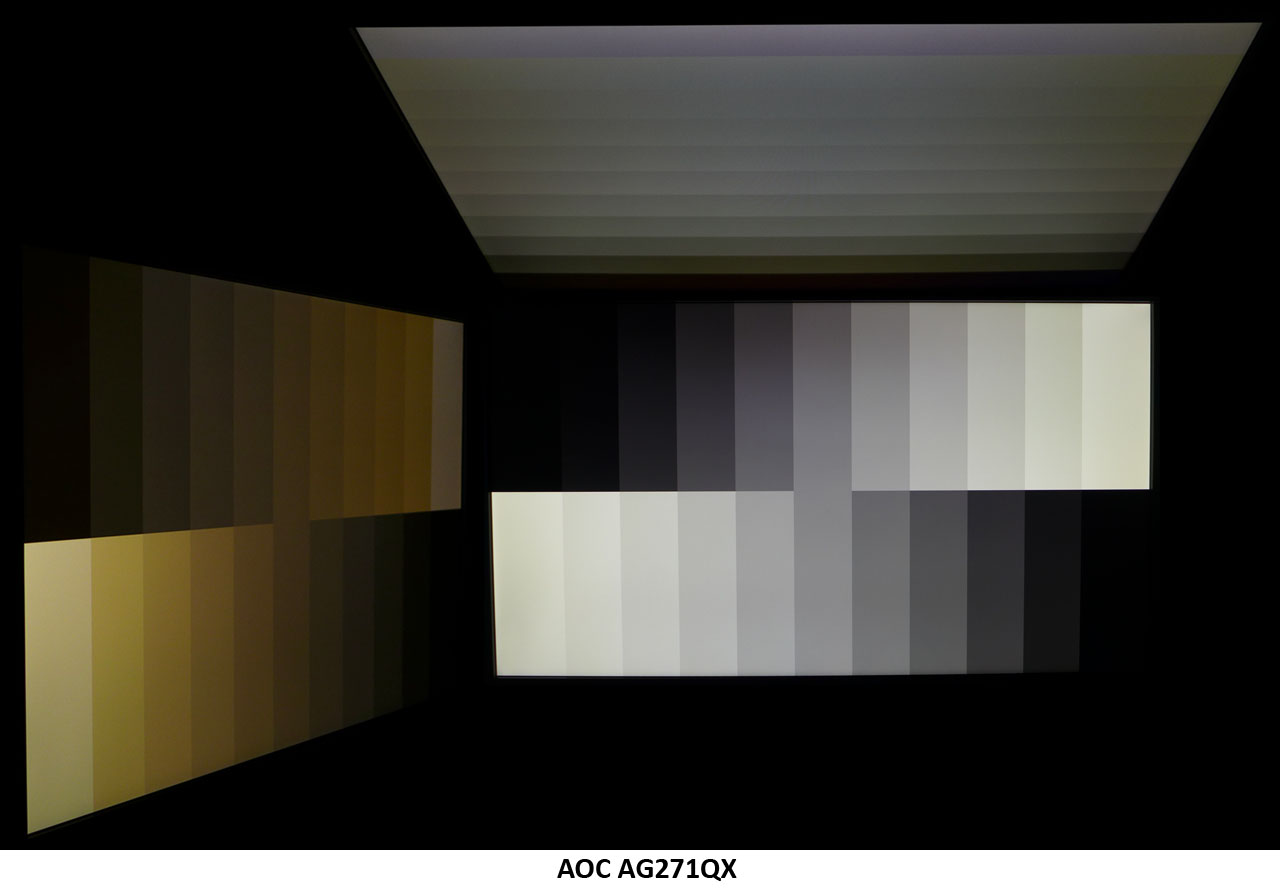AOC AG271QX Agon 27-inch FreeSync Monitor Review
Why you can trust Tom's Hardware
Viewing Angles, Uniformity, Response & Lag
The AG271QX’s viewing angles are not stellar as shown by our photos. The side view is heavily biased toward red with a significant reduction in brightness. From the top down, detail is retained in all steps, but again, output is much lower, and gamma is lighter as well. 27" is about the limit for TN screens, because any larger size would be difficult to use given the poor side view you're likely to experience. With this monitor, you can sit pretty close thanks to its QHD resolution, but we suggest keeping back at least two feet to see the best image.
Screen Uniformity
To learn how we measure screen uniformity, please click here.
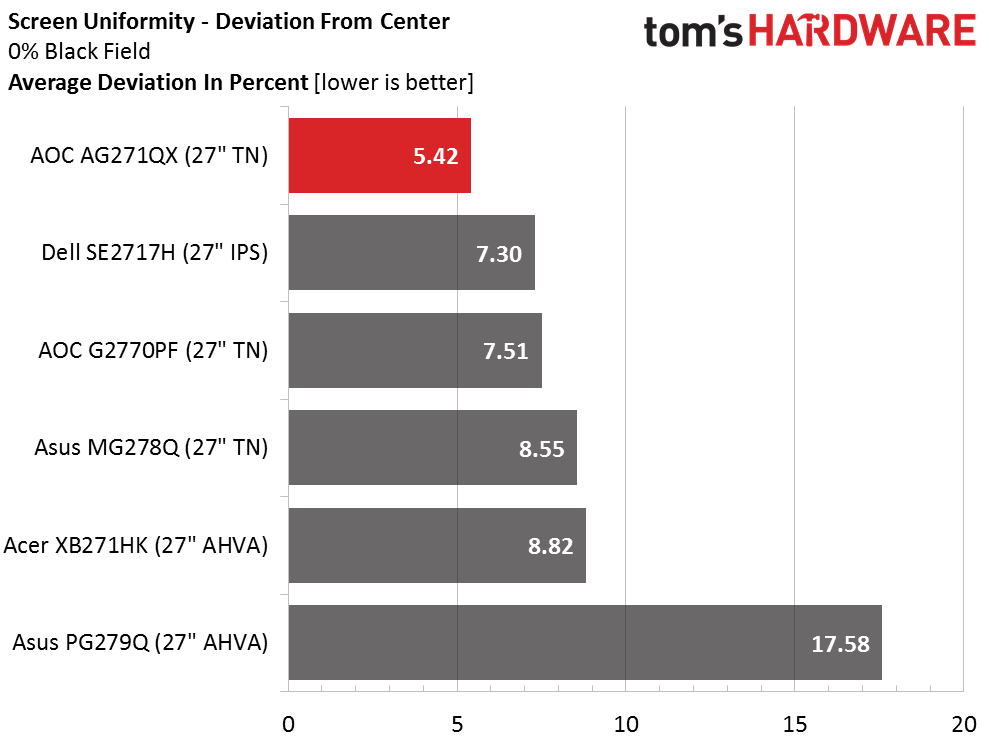
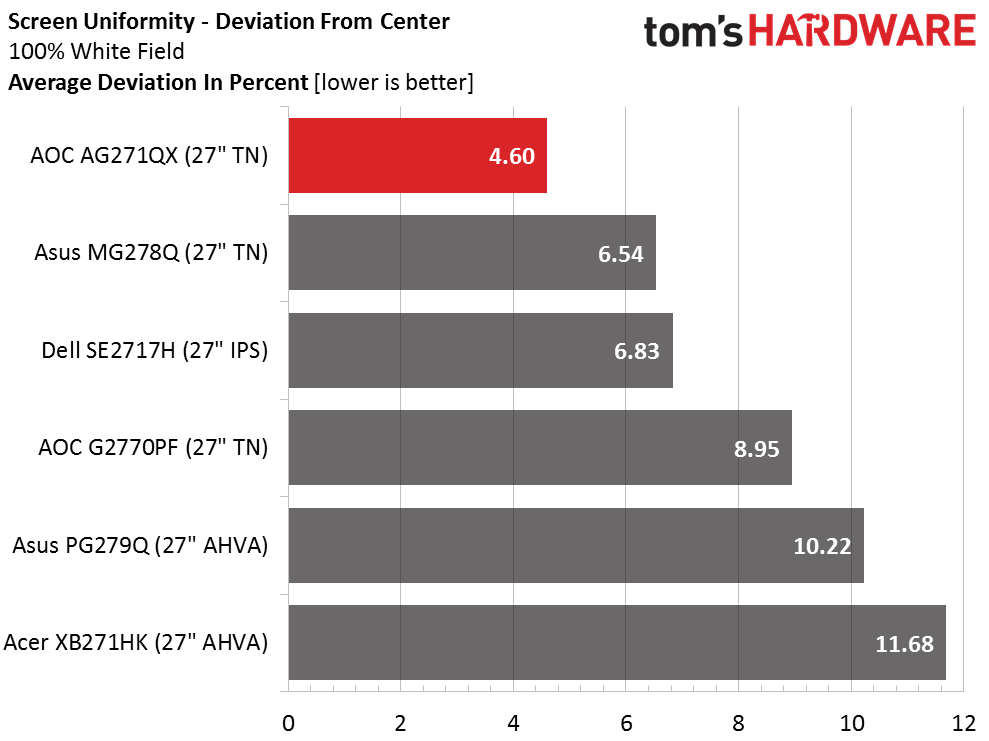
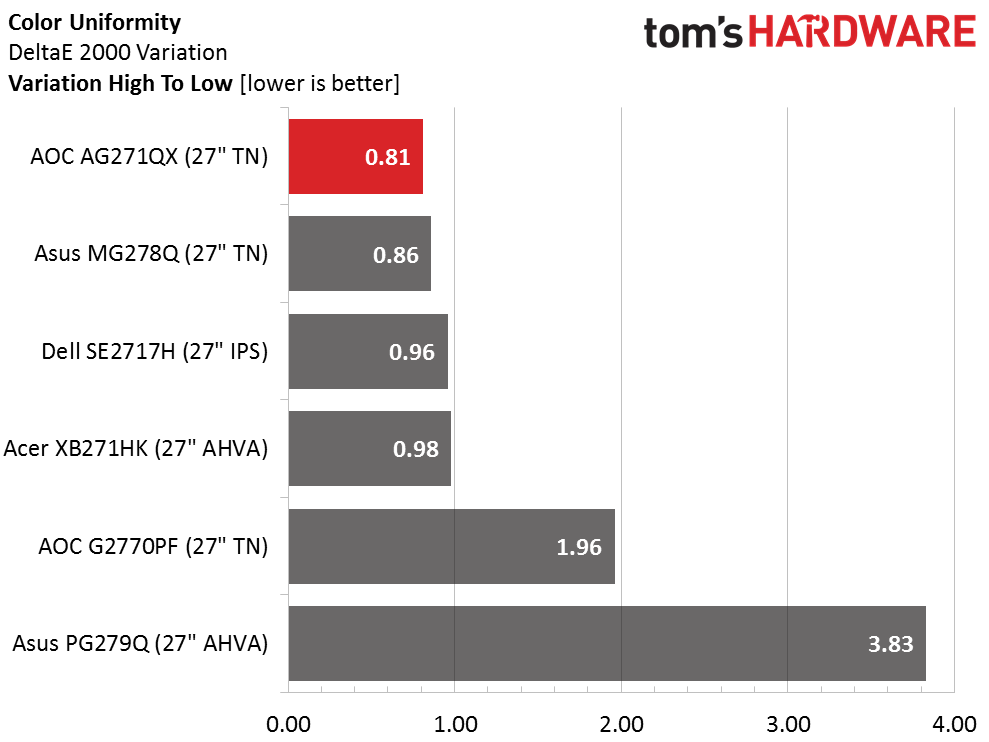
Our AG271QX sample returned one of the best uniformity results we’ve ever recorded for all three tests. Not only did it dominate this group, only a tiny handful of the monitors in our database have measured better, and then only slightly. There is no sign of bleed or glow in any area of the screen, and color looks perfect from edge to edge. There’s absolutely nothing to complain about here.
Pixel Response & Input Lag
Please click here to read up on our pixel response and input lag testing procedures.
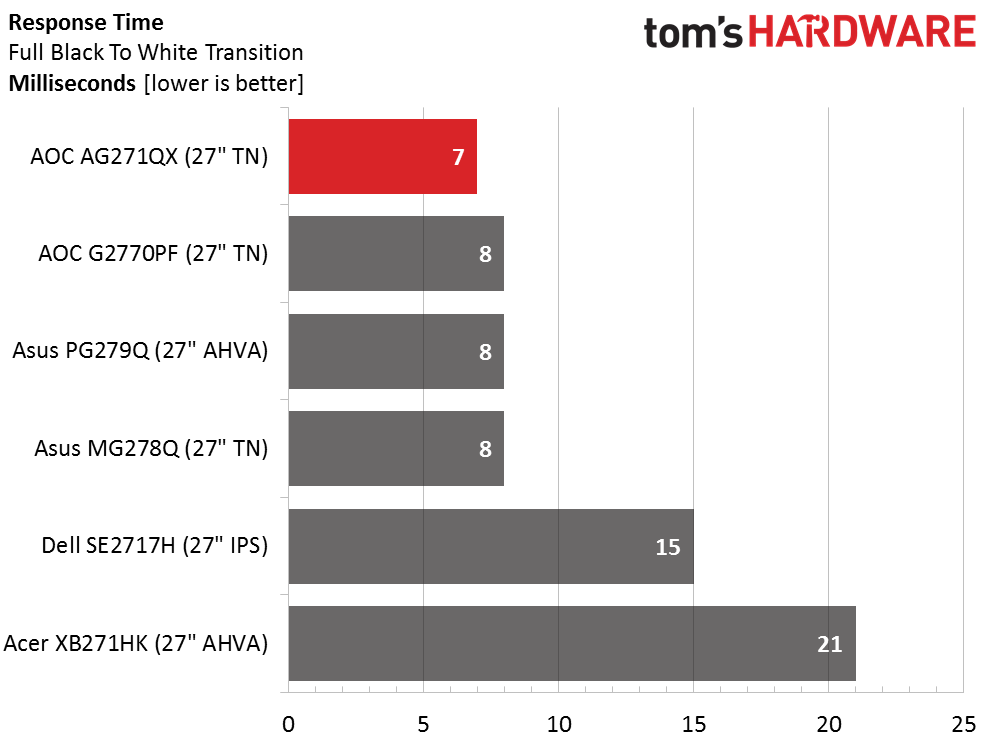
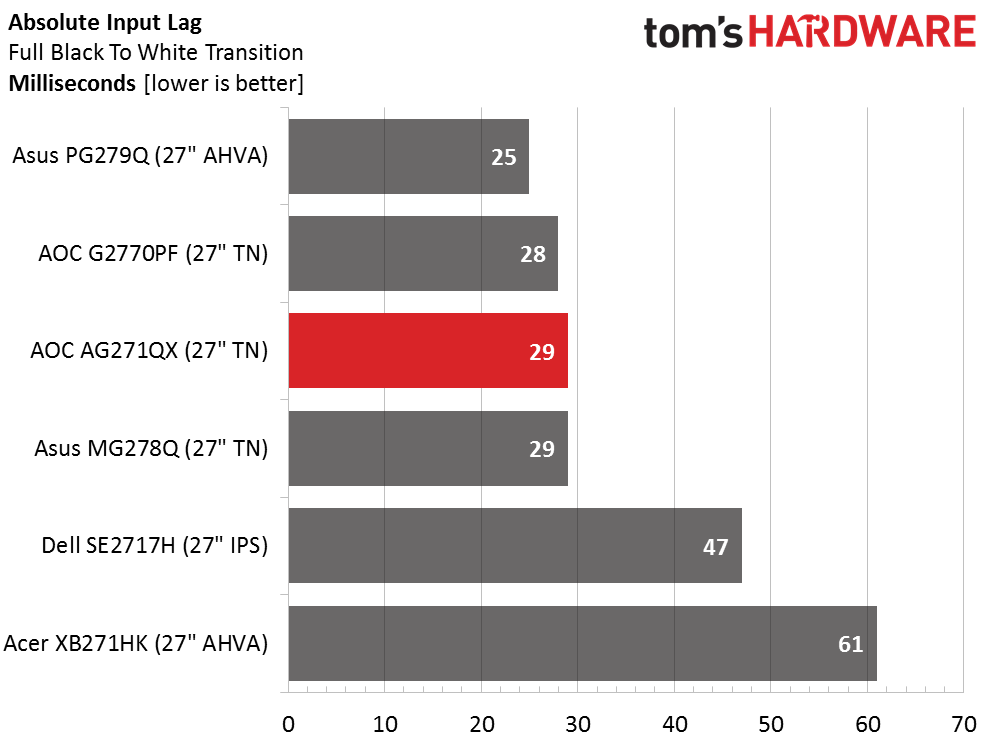
It’s easy to see why TN panels are still popular among gamers. While many users wish for IPS, it adds to the cost, and only a few premium monitors can match speeds with the old-school tech. The Asus PG279Q wins the lag test by three milliseconds thanks to its 165Hz refresh rate. At real-world framerates, there would likely be no difference. The AG271QX acquits itself extremely well, taking the response crown and returning a low 29ms of input lag in our test. This translates to very smooth motion processing, and even lower FPS counts are playable. Motion blur is practically non-existent, so there’s no missing the ULMB feature seen on G-Sync monitors.
Gaming With FreeSync
With one of the largest FreeSync operating ranges out there, the AG271QX should provide an excellent experience with a wide variety of gaming systems. Being able to keep motion free of tearing down to 30Hz is a huge advantage when you don’t possess a video card that costs four figures. Right out of the gate, this monitor proved itself to be the low framerate king. We were able to play Tomb Raider on its highest detail setting with perfectly smooth motion at 45-55 FPS average. Many other monitors will start to stutter at this speed as they close in on the lower operating limit. Staying well above 30Hz meant the Agon was never switching modes.
We experienced much the same thing in Far Cry 4. This title demands a little more speed to cleanly render the extremely fine details in plants and trees. At 45 FPS there was no tearing, but complicated textures got a little blurry. Leaving the overdrive set to strong mitigated this artifact but couldn’t completely eliminate it. Still, we had no trouble playing the game thanks to zero perceptible input lag and no tearing at any time. Even on Ultra detail, the framerate stayed above 40 FPS with our Radeon R9 285-equipped tower. The AG271QX is obviously versatile and should offer high-end performance when used with expensive and modest systems alike.
Get Tom's Hardware's best news and in-depth reviews, straight to your inbox.
Current page: Viewing Angles, Uniformity, Response & Lag
Prev Page Grayscale, Gamma & Color Next Page Conclusion
Christian Eberle is a Contributing Editor for Tom's Hardware US. He's a veteran reviewer of A/V equipment, specializing in monitors. Christian began his obsession with tech when he built his first PC in 1991, a 286 running DOS 3.0 at a blazing 12MHz. In 2006, he undertook training from the Imaging Science Foundation in video calibration and testing and thus started a passion for precise imaging that persists to this day. He is also a professional musician with a degree from the New England Conservatory as a classical bassoonist which he used to good effect as a performer with the West Point Army Band from 1987 to 2013. He enjoys watching movies and listening to high-end audio in his custom-built home theater and can be seen riding trails near his home on a race-ready ICE VTX recumbent trike. Christian enjoys the endless summer in Florida where he lives with his wife and Chihuahua and plays with orchestras around the state.
-
JQB45 I've had a standard AOC 27" 1080p 60hz monitor for nearly 4 years now and would give this a try except I don't want red.Reply -
hannibal Very good monitor indeed!Reply
Just need 4K monitor that can also go down to 30MHz, and maybe even IPS it would be perfect. But of course it would also cost a lot more.
But a good gaming monitor, this is in anyway. I personally prefer wider wieving angles, with more accurate colors, but that it only a personal preference. -
uglyduckling81 So Free-sync has the same operating frequency as G-Sync. Remind me why G-Sync monitors more expensive again?Reply
It would be amazing if they would just shit can G-Sync so we aren't screwed over by buying one type or the other.
There is no way in hell I'm buying G-Sync now that Free-Sync is it's equal but far cheaper. -
thor220 Reply19094929 said:So Free-sync has the same operating frequency as G-Sync. Remind me why G-Sync monitors more expensive again?
It would be amazing if they would just shit can G-Sync so we aren't screwed over by buying one type or the other.
There is no way in hell I'm buying G-Sync now that Free-Sync is it's equal but far cheaper.
Actually Free-Sync is theoretically better. The bottom refresh rate is 4 Hz, it's just that no monitor has implemented anything like this. -
Virtual_Singularity Thanks for the Review. Too bad the BenQ XL2730Z, known now as BenQ Zowie XL2730 (TN/FS, $549) and Acer XG270HU (TN/FS, $469) weren't included as comparison monitors, as the AOC AG271QX seems to be in direct competition with both, especially the BenQ though.Reply -
nitrium Reply
Well the reason is because nVidia is screwing its customers (who mostly lap it up) by leveraging their popularity with proprietary technology in order to maximise profits. So it's just business to them (as it should be, given they have shareholders and board to answer to). Doesn't mean you have to happy about OR support them. I stopped doing just that a few years ago, despite being an nVidiot for almost two decades.19094929 said:So Free-sync has the same operating frequency as G-Sync. Remind me why G-Sync monitors more expensive again?
It would be amazing if they would just shit can G-Sync so we aren't screwed over by buying one type or the other.
There is no way in hell I'm buying G-Sync now that Free-Sync is it's equal but far cheaper.
-
cinergy I'd be interested if this model came 24" version and lower price. If I want bigger screen, I can use my tv when needed.Reply
